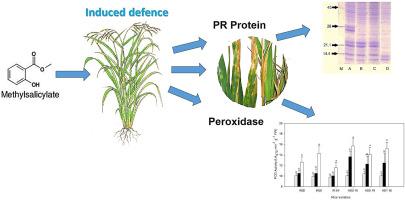当前位置:
X-MOL 学术
›
Pestic. Biochem. Phys.
›
论文详情
Our official English website, www.x-mol.net, welcomes your
feedback! (Note: you will need to create a separate account there.)
Seed treatment and foliar application of methyl salicylate (MeSA) as a defense mechanism in rice plants against the pathogenic bacterium, Xanthomonas oryzae pv. oryzae
Pesticide Biochemistry and Physiology ( IF 4.2 ) Pub Date : 2021-01-01 , DOI: 10.1016/j.pestbp.2020.104718 Kandasamy Kalaivani , Marimuthu Maruthi-Kalaiselvi , Sengottayan Senthil-Nathan
Pesticide Biochemistry and Physiology ( IF 4.2 ) Pub Date : 2021-01-01 , DOI: 10.1016/j.pestbp.2020.104718 Kandasamy Kalaivani , Marimuthu Maruthi-Kalaiselvi , Sengottayan Senthil-Nathan

|
Methyl salicylate (MeSA) is a volatile biological compound synthesized from salicylic acid (SA) and is a plant hormone that helps defend against pests and pathogens. A major bacterial pathogen of rice, Xanthomonas oryzae pv. oryzae (Xoo) causes severe disease. Seed and plant treatments with MeSA can stimulate the defense enzyme peroxidase (POD) in plants. Response of peroxidase activity in rice (Oryza sativa L) cultivars IR 20, IR 50, IR 64, ASD 16, ASD 19 and ADT 46 to MeSA were measured under greenhouse conditions. Treatments of rice seedlings with MeSA at 50 and 100 mg L-1 significantly upregulated POD expression in the plants. The activity of POD was also significantly upregulated when plants were inoculated with bacterial blight. Effects were stronger in ASD 16, ASD 19 and ADT 46 and were more pronounced in high dose treatment (100 mg L-1) when inoculated with bacterial blight condition and the effects were dose dependent, although the relationship between dose and rice varieties were not always linear. The pathogenic related (PR) protein bands at 33 kDa and 14 kDa were identified in treatments of 100 mg L-1 MeSA in the presence of bacterial blight disease. Band intensity was estimated to be twice that of those from pathogen induce MeSA levels in rice plants. These results suggest that treatment with MeSA can significantly increase the POD defense related enzyme by altering the plant physiology in ways that may be beneficial for crop protection.
中文翻译:

水杨酸甲酯 (MeSA) 的种子处理和叶面施用作为水稻植物对抗病原菌 Xanthomonas oryzae pv. 的防御机制。米科
水杨酸甲酯 (MeSA) 是一种由水杨酸 (SA) 合成的挥发性生物化合物,是一种有助于抵御害虫和病原体的植物激素。水稻的主要细菌病原体,米黄单胞菌 pv。oryzae (Xoo) 会导致严重的疾病。用 MeSA 处理种子和植物可以刺激植物中的防御酶过氧化物酶 (POD)。在温室条件下测量水稻 (Oryza sativa L) 栽培品种 IR 20、IR 50、IR 64、ASD 16、ASD 19 和 ADT 46 中过氧化物酶活性对 MeSA 的响应。用 50 和 100 mg L-1 的 MeSA 处理水稻幼苗显着上调了植物中的 POD 表达。当植物接种白枯病时,POD 的活性也显着上调。ASD 16 的效果更强,ASD 19 和 ADT 46 在高剂量处理 (100 mg L-1) 中接种细菌枯萎病时更为显着,并且效果是剂量依赖性的,尽管剂量与水稻品种之间的关系并不总是线性的。在存在细菌性枯萎病的情况下,在 100 mg L-1 MeSA 处理中鉴定了 33 kDa 和 14 kDa 的致病相关 (PR) 蛋白条带。条带强度估计是水稻植株中病原体诱导 MeSA 水平的两倍。这些结果表明,用 MeSA 处理可以通过以可能有益于作物保护的方式改变植物生理来显着增加 POD 防御相关酶。在存在细菌性枯萎病的情况下,在 100 mg L-1 MeSA 处理中鉴定了 33 kDa 和 14 kDa 的致病相关 (PR) 蛋白条带。条带强度估计是水稻植株中病原体诱导 MeSA 水平的两倍。这些结果表明,用 MeSA 处理可以通过以可能有益于作物保护的方式改变植物生理来显着增加 POD 防御相关酶。在存在细菌性枯萎病的情况下,在 100 mg L-1 MeSA 处理中鉴定了 33 kDa 和 14 kDa 的致病相关 (PR) 蛋白条带。条带强度估计是水稻植株中病原体诱导 MeSA 水平的两倍。这些结果表明,用 MeSA 处理可以通过以可能有益于作物保护的方式改变植物生理来显着增加 POD 防御相关酶。
更新日期:2021-01-01
中文翻译:

水杨酸甲酯 (MeSA) 的种子处理和叶面施用作为水稻植物对抗病原菌 Xanthomonas oryzae pv. 的防御机制。米科
水杨酸甲酯 (MeSA) 是一种由水杨酸 (SA) 合成的挥发性生物化合物,是一种有助于抵御害虫和病原体的植物激素。水稻的主要细菌病原体,米黄单胞菌 pv。oryzae (Xoo) 会导致严重的疾病。用 MeSA 处理种子和植物可以刺激植物中的防御酶过氧化物酶 (POD)。在温室条件下测量水稻 (Oryza sativa L) 栽培品种 IR 20、IR 50、IR 64、ASD 16、ASD 19 和 ADT 46 中过氧化物酶活性对 MeSA 的响应。用 50 和 100 mg L-1 的 MeSA 处理水稻幼苗显着上调了植物中的 POD 表达。当植物接种白枯病时,POD 的活性也显着上调。ASD 16 的效果更强,ASD 19 和 ADT 46 在高剂量处理 (100 mg L-1) 中接种细菌枯萎病时更为显着,并且效果是剂量依赖性的,尽管剂量与水稻品种之间的关系并不总是线性的。在存在细菌性枯萎病的情况下,在 100 mg L-1 MeSA 处理中鉴定了 33 kDa 和 14 kDa 的致病相关 (PR) 蛋白条带。条带强度估计是水稻植株中病原体诱导 MeSA 水平的两倍。这些结果表明,用 MeSA 处理可以通过以可能有益于作物保护的方式改变植物生理来显着增加 POD 防御相关酶。在存在细菌性枯萎病的情况下,在 100 mg L-1 MeSA 处理中鉴定了 33 kDa 和 14 kDa 的致病相关 (PR) 蛋白条带。条带强度估计是水稻植株中病原体诱导 MeSA 水平的两倍。这些结果表明,用 MeSA 处理可以通过以可能有益于作物保护的方式改变植物生理来显着增加 POD 防御相关酶。在存在细菌性枯萎病的情况下,在 100 mg L-1 MeSA 处理中鉴定了 33 kDa 和 14 kDa 的致病相关 (PR) 蛋白条带。条带强度估计是水稻植株中病原体诱导 MeSA 水平的两倍。这些结果表明,用 MeSA 处理可以通过以可能有益于作物保护的方式改变植物生理来显着增加 POD 防御相关酶。











































 京公网安备 11010802027423号
京公网安备 11010802027423号